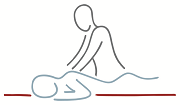Impact injuries
Crashes are an unfortunate part of cycling. Potholes, careless drivers and mis-communication amongst group members can all result in you ending up on the road or in the hedge. If you have fallen heavily, seek medical attention in order to rule out any broken bones or concussion. A helmet could save your life and should always be worn.
Concussion is a blow to the brain and requires medical attention followed by a sensible rest period away from exercise and screens.
One of the most common bones to be broken in cycling is the collar bone and whilst this will take about six weeks to mend, indoor cycling on a turbo trainer or in the gym will be possible. Other breaks may require you to lay off cycling of all types for a while.
Muscles can also be strained during an impact or fall and will be less obvious than a break. If these are not rested and allowed to mend then overuse injuries can occur in the compensating muscles. If you have had a serious crash it may be a good idea to get checked out by a physiotherapist before returning to cycling to make sure that your body is properly aligned.
Road rash is often the most annoying result of a crash. This grazing of the skin caused by skidding along the tarmac will sting like mad and can take a while to heal. Keeping the graze clean is vital and all the bits of dirt and stones will need to be washed out before any dressings can be applied.
Over – use injuries
Whilst crashes are an obvious source of injury, over use injuries tend to creep up on us and we only notice the problem when pain occurs. They will be due to something being wrong in our body alignment, bike set up or fitness. This source problem needs to be resolved to stop the injury re-occurring.
Low back pain
This is common in cyclists due to bending over the handlebars for long periods of time. Check your position on the bike. If you have a long stem and low handlebars think about adjusting this to alleviate the pressure on your back. In addition, posture off the bike and work station set up in the office can have a big impact on the health of your back muscles. Strengthen your core to help support your back and give yourself a more powerful base to push from.
Knee pain
Often results from a bike fit problem. A correctly set up and properly fitting bike is vitally important in the quest to remain injury free. The long distances involved and repetitive nature of cycling mean that slight imbalances can cause big problems. A professional bike fit is always advisable if you are buying a new bike, planning to dramatically increase distance, have a history of injury or are changing cycling disciplines. I can recommend Callum Hughes at Velo Clinic in Newbury for this service.
Pain in the front of the knee often comes from a saddle that is too low. The opposite is true for pain behind the knee as a too high saddle puts strain on the hamstrings. Pains at the side of the knee can be caused by incorrect cleat set up impacting the patella tracking. Pain on the outside of the knee can be eased by rotating cleats to turn toes outwards, whereas pain on the inside of the knee needs the toes to point slightly inwards.
Pain in the neck, arms or wrist
Problems in the arms are often caused by too much pressure being transmitted through the upper body. In an ideal set up, approx. 60% of your body weight should be positioned at the rear of the bike with only 40% at the front. If too much weight goes through your arms and hands then they will feel the strain. If this is an issue, the first thing to check is that your reach is not too long, nor your handlebars too low. Adjust the position of your handlebars and hoods to find the most comfortable angle. Compact or shallow drop handlebars may be a good option.
Tingling or numbness in the fingers is caused by compression of the nerves running through narrow tunnels in the wrist. Good quality, well padded mitts can help. If the problem worsens and affects you off the bike, medical treatment may be required to alleviate the inflammation in the wrists.

